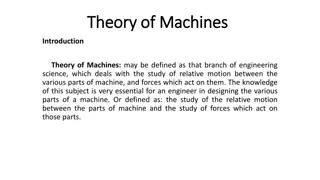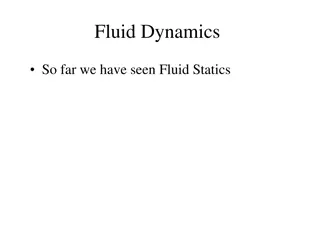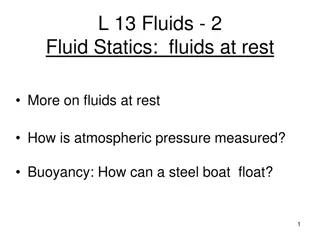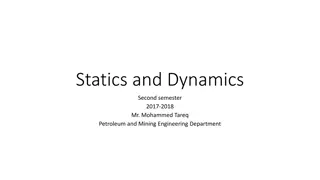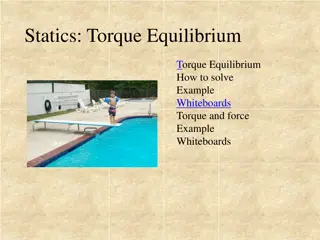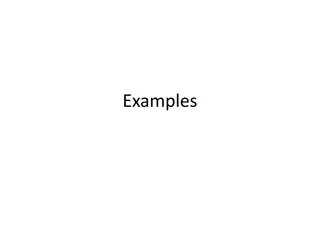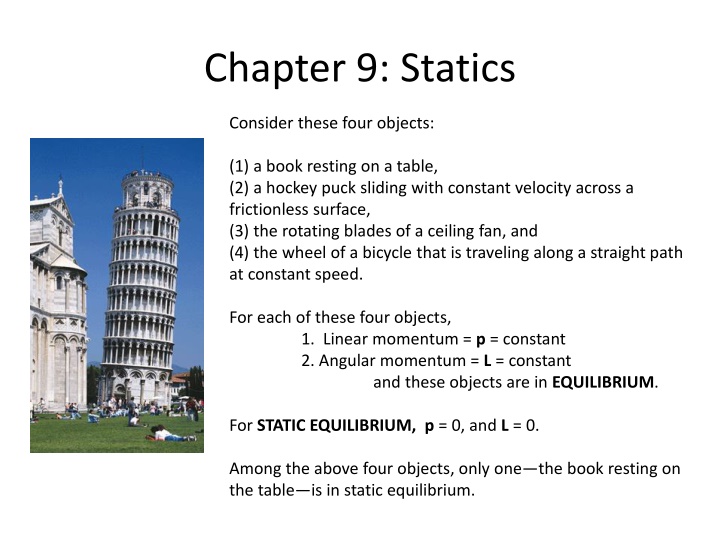
Equilibrium Conditions and Applications in Physics
Learn about static equilibrium, equilibrium requirements, equations for equilibrium, and how to apply equilibrium conditions to rigid bodies in physics. Explore examples and problems related to static equilibrium and forces in various objects.
Download Presentation

Please find below an Image/Link to download the presentation.
The content on the website is provided AS IS for your information and personal use only. It may not be sold, licensed, or shared on other websites without obtaining consent from the author. If you encounter any issues during the download, it is possible that the publisher has removed the file from their server.
You are allowed to download the files provided on this website for personal or commercial use, subject to the condition that they are used lawfully. All files are the property of their respective owners.
The content on the website is provided AS IS for your information and personal use only. It may not be sold, licensed, or shared on other websites without obtaining consent from the author.
E N D
Presentation Transcript
Chapter 9: Statics Consider these four objects: (1) a book resting on a table, (2) a hockey puck sliding with constant velocity across a frictionless surface, (3) the rotating blades of a ceiling fan, and (4) the wheel of a bicycle that is traveling along a straight path at constant speed. For each of these four objects, 1. Linear momentum = p = constant 2. Angular momentum = L = constant and these objects are in EQUILIBRIUM. For STATIC EQUILIBRIUM, p = 0, and L = 0. Among the above four objects, only one the book resting on the table is in static equilibrium.
The Requirements for Equilibrium Requirements for a body to be in equilibrium are as follows: 1. The vector sum of all the external forces that act on the body must be zero. 2. The vector sum of all external torques that act on the body, measured about any possible point, must also be zero. Requirements for a body to be in static equilibrium are as follows: 1. The vector sum of all the external forces that act on the body must be zero. 2. The vector sum of all external torques that act on the body, measured about any possible point, must also be zero. 3. The linear momentum of the body must be zero. 4. The angular momentum of the body must be zero.
Applying the Conditions of Equilibrium to a Rigid Body 1.Select the object to which the equations for equilibrium are to be applied. 2.Draw a free-body diagram that shows all the external forces acting on the object. 3.Choose a convenient set of x, y axes and resolve all forces into components that lie along these axes. 4.Apply the equations that specify the balance of forces at equilibrium: Fx = 0 and Fy = 0. 5.Select a convenient axis of rotation. Identify the point where each external force acts on the object, and calculate the torque produced by each force about the axis of rotation. Set the sum of the torques about this axis equal to zero: = 0. 6.Solve the equations for the desired unknown quantities.
Problem The drawing shows a person, weight = 584 N, doing push-ups. Find the normal force exerted by the floor on each hand and each foot, assuming that the person holds this position.
Muscles Exert Bigger Forces Than You Might Think Calculate the force the biceps muscle must exert to hold the forearm and its load as shown in Figure 9.27, and compare this force with the weight of the forearm plus its load.
The Achilles Tendon Figure shows the ankle joint and the Achilles tendon attached to the heel at point P. The tendon exerts a force 720 N, as the Figure indicates. Determine the torque (magnitude and direction) of this force about the ankle joint, which is located away from point P.
Achilles Tendon 33. A 75-kg man stands on his toes by exerting an upward force through the Achilles tendon, as in Figure 9.42. (a) What is the force in the Achilles tendon if he stands on one foot? (b) Calculate the force at the pivot of the simplified lever system shown that force is representative of forces in the ankle joint.
Problem A shop sign weighing 220 N is supported by a uniform 120-N beam as shown below. 1. Draw a free-body diagram for the beam, showing all the forces acting on the beam. 2. Break the tension in the guy wire into horizontal and vertical components. 3. Write down two equations by balancing the forces in x and y directions. 4. Write down the torque equation. 5. Find the tension in the guy wire and the horizontal and vertical forces exerted by the hinge on the beam.


